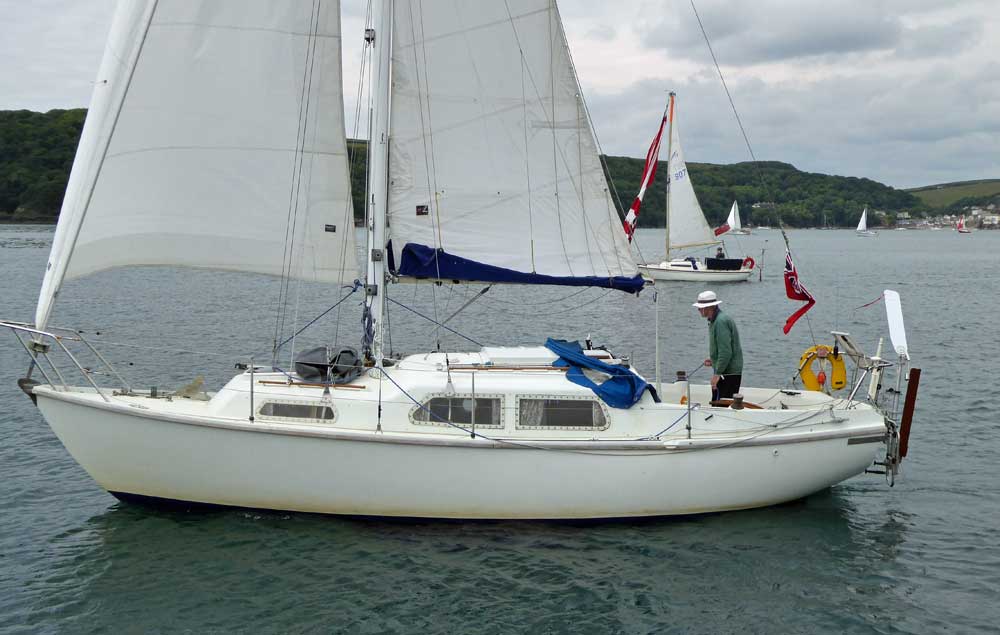- Home
- Cruiser Yachts under 30'
- Sabre 27
The Sabre 27 Sailboat
The Sabre 27, a masthead sloop, was designed by Alan Hill and built in the UK by Marine Construction Ltd.
 The skipper of this Sabre 27 has long-distance plans - check the windvane self-steering gear on the stern...
The skipper of this Sabre 27 has long-distance plans - check the windvane self-steering gear on the stern...Published Specification for the Sabre 27
Underwater Configuration: Fin keel and skeg-hung rudder
Hull Material: GRP (fibreglass)
Length Overall: 27' 0" / 8.2m
Waterline Length: 22' 2" / 6.8m
Beam: 9' 0" / 2.7m
Draft: 4' 6" / 1.4m
Rig Type: Masthead Sloop
Displacement: 6,800lb / 3,084kg
Designer: Alan Hill
Builder: Marine Construction Ltd (UK)
Year First Built: 1969
Year Last Built: 1979
Number Built: 400
Owners Association: Sabre 27 Owners' Association
Published Design Ratios for the Sabre 27
Sail Area/Displacement Ratio: 14.3
Ballast/Displacement Ratio: 45.6
Displacement/Length Ratio: 279
Comfort Ratio: 23.8
Capsize Screening Formula:
Summary Analysis of the Design Ratios for the Sabre 27
A Sail Area/Displacement Ratio of just 14.3 suggests that she'll need a stiff breeze to get her going. In any other conditions, unless you've got plenty of time on your hands, motor-sailing will be the way to go.
A Ballast/Displacement Ratio of 45.6 means that she'll stand up well to her canvas in a blow, helping her to power through the waves.
A Displacement/Length Ratio of 279, tells us she's clearly a heavy displacement cruising boat. You can load her down with all your cruising gear and equipment and it will hardly affect her waterline. Not an ideal choice for coastal sailing, but will come into her own on an offshore passage in testing conditions.
Ted Brewer's Comfort Ratio of 23.8 suggests that crew comfort in a seaway is similar to what you would associate with the motion of a coastal cruiser, which is not encouraging news for anyone prone to seasickness.
Her Capsize Screening Formula of 1.9 tells us that she would be a better choice of sailboat for ocean passage-making than one with a CS rating of more than 2.0.
The Sabre 27 Sailboat: An Article
The Sabre 27 is a British design that has been around since 1969 and still has a loyal following of owners and enthusiasts. In this article, we will give you an overview of the Sabre 27, its accommodation, hull and deck, mast and rigging, keel and rudder, and some of the options and variations that are available. We hope this will help you decide if the Sabre 27 is the right boat for you.
Overview
The Sabre 27 was designed by Alan F Hill, a naval architect who also created the popular Westerly Centaur and Longbow. The prototype was built in 1969 by Eric White of Marine Construction (UK) Ltd. (Marcon), who produced about 400 hulls until 1982. After Marcon went into liquidation, the moulds were bought by Brue Yachts of Highbridge, Somerset, who made a few more boats until the early 1990s.
The Sabre 27 is a sloop-rigged cruiser with a moderate displacement of about 3.5 tonnes and a generous beam of 2.8 metres. She has a length overall of 8.2 metres and a waterline length of 6.4 metres. She draws 1.4 metres with a fin keel or 1.1 metres with twin bilge keels. She has a spacious cockpit with a tiller steering and a bridgedeck-mounted mainsheet traveller. She can accommodate up to six people in two cabins, with a separate head compartment and a galley.
The Sabre 27 is not as close-winded as a modern fin-keeler but can muster respectable boat speed on passage – quicker than her twin-keeled sisters – and handles easily. She has a deck-stepped mast that can be easily lowered for canal use. She sports a single-spreader rig with fore-and-aft lowers and a split backstay, setting a small genoa relative to her mainsail. She has a solid GRP hull with no core material and a GRP deck with a balsa core.
The Sabre 27 is a boat that appeals to sailors who value simplicity, practicality, and affordability over luxury, speed, and sophistication. She is a boat that can take you places without breaking the bank or requiring too much maintenance. She is a boat that has stood the test of time and still has a lot to offer.
Accommodation
The Sabre 27 has a surprisingly roomy interior for her size, thanks to her wide beam and good form stability. She can sleep up to six people in two cabins: two in the fore-cabin, two in the saloon settees (one of which converts to a double berth), and two in the quarter berth aft of the navigation station.
The accommodation is finished in teak veneer with blue upholstery. The headroom is about 1.8 metres in the saloon and 1.6 metres in the fore-cabin. The cabin is well-ventilated by opening hatches and portlights, and well-lit by overhead lights and reading lights. The cabin is heated by a gas heater mounted on the forward bulkhead.
The Sabre 27 offers a comfortable and cozy living space for a small family or a couple with occasional guests. She has enough storage space for cruising gear and provisions, and enough amenities for basic cooking and washing. She is not a luxury yacht, but she is a home away from home.
Hull and Deck
The Sabre 27 has a solid GRP hull with no core material, which makes her strong and durable. The hull shape is round-bilged with a moderate flare at the bow and a slight tumblehome at the stern. The hull has a white gelcoat finish with a blue cove line and boot top.
The deck is made of GRP with a balsa core, which makes it light and stiff. The deck has a moulded non-slip pattern and a teak toe rail. The deck fittings include stainless steel bow and stern pulpits, stanchions and guardrails, mooring cleats, fairleads, bow roller, anchor locker, chainplates, genoa tracks and cars, winches, cleats, clutches, halyard organisers, vents, dorade boxes, handrails, and cockpit coamings. The deck has a white gelcoat finish with blue stripes.
The cockpit is spacious and comfortable, with a tiller steering and a bridgedeck-mounted mainsheet traveller. The cockpit seats are long enough to lie down on, and have lockers under them for storage. The cockpit also has a gas locker, a lazarette, and a stern locker. The cockpit drains through two large scuppers. The cockpit is protected by a sprayhood and a dodger.
The Sabre 27 has a well-built and well-equipped hull and deck that can handle various sea conditions and provide safety and convenience for the crew. She has a classic and attractive appearance that reflects her heritage and character.
Mast and Rigging
The Sabre 27 has a deck-stepped mast that can be easily lowered for canal use. The mast is made of aluminium alloy and has a single set of spreaders. The mast is supported by stainless steel standing rigging that includes forestay, backstay (split), cap shrouds, lower shrouds (fore-and-aft), and intermediate shrouds. The mast also has internal halyards for the mainsail and the genoa.
The Sabre 27 has a sloop rig with a small genoa relative to her mainsail. The genoa is set on a roller furling system that allows easy reefing and stowing. The mainsail is set on a boom with slab reefing and lazyjacks. The mainsail has two or three reefing points, depending on the sailmaker. The sails are made of Dacron or similar material.
The Sabre 27 has a simple and efficient rig that can be easily handled by one or two people. She has enough sail area to give her good performance in light to moderate winds, but also enough reefing options to cope with stronger winds. She has a balanced helm that responds well to sail trimming.
Keel and Rudder
The Sabre 27 has two keel options: a fin keel or twin bilge keels. The fin keel is made of cast iron and has a ballast ratio of about 40%. The fin keel draws 1.4 metres and gives the boat better upwind performance and manoeuvrability. The twin bilge keels are also made of cast iron and have a ballast ratio of about 35%. The twin bilge keels draw 1.1 metres and allow the boat to dry out on tidal moorings or beaches.
The Sabre 27 has a spade rudder that is hung on a stainless steel stock. The rudder is made of GRP with foam core. The rudder is steered by a tiller that is connected to the stock by a universal joint. The tiller has an extension that can be used for better visibility or comfort.
The Sabre 27 has a keel and rudder configuration that suits different sailing preferences and locations. She can be sailed in shallow waters or deep waters, in tidal areas or non-tidal areas, with ease and confidence.
Options and Variations
The Sabre 27 has some options and variations that can make her more suitable for different sailors or purposes. Some of these are:
- Owner's version: This version has a larger fore-cabin with more storage space and an enclosed heads compartment. The saloon settee on the port side is shortened to make room for the heads door. This version sacrifices some sleeping space for more privacy and comfort.
- Charter version: This version has more sleeping space by converting the navigation station into another quarterberth. The chart table is moved to the starboard side of the saloon, where it can be folded down when not in use. This version sacrifices some working space and storage space for more sleeping space.
- Engine options: The Sabre 27 was originally fitted with a Volvo Penta MD2B 25 hp diesel engine with a shaft drive and a fixed two-bladed propeller. Later models had a Volvo Penta 2002 18 hp diesel engine with a saildrive and a folding two-bladed propeller. Some owners have replaced the original engine with a Beta Marine 20 hp diesel engine with a shaft drive and a three-bladed propeller.
- Mast height options: The Sabre 27 has two mast height options: standard or tall. The standard mast is about 10.5 metres high and has a sail area of about 39 square metres. The tall mast is about 11.5 metres high and has a sail area of about 43 square metres. The tall mast gives the boat more power in light winds, but also more heel and weather helm in strong winds.
The Sabre 27 has some options and variations that can make her more suitable for different sailors or purposes. Some of these are based on the original design, while others are based on modifications made by owners or builders. The Sabre 27 is a versatile boat that can be adapted to different needs and preferences.
This article was written with the assistance of Gemini, a large language model developed by Google. Gemini was used to gather information, summarize research findings, and provide suggestions for the content and structure of the article.
Recent Articles
-
Is Marine SSB Still Used?
Apr 15, 25 02:05 PM
You'll find the answer to this and other marine SSB-related questions right here... -
Is An SSB Marine Radio Installation Worth Having on Your Sailboat?
Apr 14, 25 02:31 PM
SSB marine radio is expensive to buy and install, but remains the bluewater sailors' favourite means of long-range communication, and here's why -
Correct VHF Radio Procedure: Your Questions Answered
Apr 14, 25 08:37 AM
Got a question about correct VHF radio procedure? Odds are you'll find your answer here...













